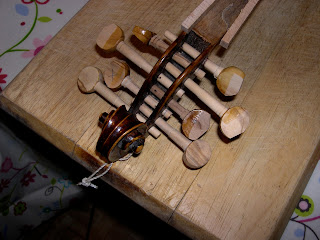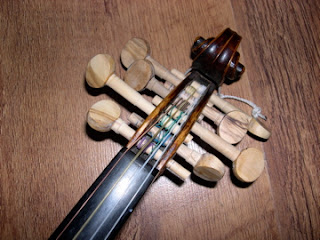09/11/11
Project initiation!
An old Hopf violin kindly donated by Fiddlin' Bob Torrens of Bangor, Co. Down. The plan is to set it up for 8 strings, four as per a violin, and four sympathetic running in a tunnel under the finger board. Spent the large part of a day considering pegbox options.
Others have replaced the pegbox with a mandolin type head with tuners, but I would like to keep the pegs if possible. So its a question of either extending the pegbox, or trying to cram more pegs in to the existing layout.
Maybe join two pegboxes together?
Tricky.
Or use much smaller pegs, for example from this Pakistani oud:
Although this looks a bit tight.
Whatever the choice, I would have to re-bush the pegbox so as to tighten things up. The first problem is that the existing pegs are very thick (and the peg holes consequently very large), and also are not the usual 1/30 taper, so I couldn't just ease the old pegs in a bit to make the bushings, or make up tapered dowels from e.g. wooden spoons from the kitchen. Brand new pegs (thick enough for the large holes) would have to be sacrificed.I shelved this problem for a while, and spent the rest of the afternoon removing the fingerboard.
10/11/11
Glued in four nice new rosewood pegs...

...and trimmed them off more or less flush with the cheeks:

Most others have fashioned the channel for the sympathetic strings by making a 3/32" deep channel in both the neck and the fingerboard. As the neck and fingerboard on the Hopf are quite slim, and the tubby belly currently results in quite a low bridge...

...I decided to raise the fingerboard off the neck by the required amount by using 3/16" maple strips. I cut the strips after going to town to get new coping saw blades.
19/11/11
Finished trimming off the pegs a.k.a. bushes. I had to re-glue one not having slabbered enough glue on in the first place.

Also figure out where to drill out all the holes. Not much room for error here.
 20/11/11
20/11/11
Mark out...

...and drill pilot holes, checking for alignment with toothpicks. Holes 6 and 8 will need to be adjusted when reaming.

I need a 13/64 drill bit...
05/01/12
Drill and ream holes to minimum.
After some thought I decided to use some old olive wood pegs from a previous oud upgrade.
Fit roughly to peg-holes.
Hmmm.
06/01/12
Various options were considered, but for now just tidy things up by reducing the peg head size (to about 1/4) and see how things work out in practice. Some extra tweaking is needed as the reamer cut at different rates through the maple and the rosewood, so the taper of the pegs needs shaved in some cases.
Turning to the neck and fingerboard, prepare two maple strips which will form the 'walls' of the under-string channel. The plan is for a 3/16 gap, with maybe a bit of taper towards the nut.
26/01/12
Shape the strips to 3/16s square, trim to length, and glue them to the neck.
Roughly shape the under-string nut from an old ordinary nut.
Glue on the nut (not in shot) and then finger board over the top.
And that's the neck / fingerboard assembly finished.
02/02/12
Right, clean up pegs, fit bridge and soundpost, drill understring holes in bridge, and drill four extra holes in the tailpiece, again for the understrings.
Here is the initial setup, without understrings for now, using old Chorda 'G' and 'D', and Nylgut guitar strings for the 'A' and 'E'. These last two don't work that well, but are good enough for testing. The peg layout is awkward as regards the shorter pegs, but it should serve.
You can just about see the understring nut here.
And here the understring holes in both the tailpiece and the bridge.
03/02/12
Add on the understrings (old violin 'E' strings for now)
The understrings go to the first four pegs, the main strings to the back four. This works out quite well and all the strings get a fairly clean run.
Everything is in pretty good shape, except the pegs, which are awkward in the case of the shorter pegs, and don't turn smoothly enough. I've a notion that it might be better to lose the heads and sort out some sort of key for tuning cf. harps.
And here's a sound clip:
09/02/12
The peg arrangement works, but the inner pegs are awkward, especially the top two. I decided to make a
narka, a peg wrench for sitar sympathic strings, which does the job nicely.
Also the nylgut strings don't really work. I replaced them with various odds and ends, and retuned to 'standard' hardanger tuning (ADAE). Lots better.
OK - set of nearly new Dominants, and D'Addario '9's and '10's for the drones. Without fine tuners all round its hard to get it tuned dead on, but here's a gritty version of 'Sal's Got Mud Between Her Toes'...
29/03/12
"Without fine tuners all round its hard to get it tuned dead on....."
So, using the mother-in-laws olive wood spoon...
The back tuners have had the prongs taken off. The plan is to use loop ended strings running under.
08/04/12
Complete spoon-to-tailpiece transformation.
Re-install pegs, making them all the same length. The fingerboard was slightly out of line from the last glueing, so re-do this while I'm at it.
Also reduce the head size (so they turn past each other).
Et violá. The tailpiece doesn't look too out-of-place, and the fine tuners are a vast improvement, although the whole assemblage is a bit on the heavy side. With the tuners the pegs don't need to perform perfectly. They are a bit fiddly to work with, but steel strings and the narka make it workable.
13/04/12
'Gate To Go Through', a=392, GDAe (DEGA), Precision Light overstrings, 010 understrings.

















































